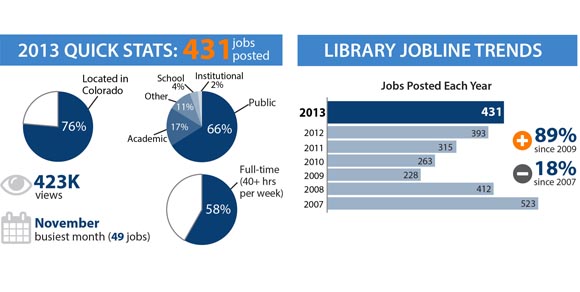In our yearly tradition, our newest Fast Facts reviews the past year of Library Jobline, our popular library jobs posting website. We investigate the kinds of jobs that are posted, what skills are required, and how 2013 was in the larger trends of the library job market. Here’s what we found:
In 2013, 431 jobs were posted on Library Jobline. That’s up almost 90% from 2009, the bottom of the job posting curve thanks to the latest recession. But we’ve not yet recovered completely: 523 jobs were posted in 2007, the first year of the service.
Average starting wages for postings not requiring an MLIS/MLS degree have increased more than 20% since 2007, more than starting wages for postings preferring (up 16%) or requiring (up just 4%) the degree. In fact, the average starting wage for positions requiring an MLIS in 2013 was $22.25 while postings preferring the degree had an average starting wage of $22.08—a difference of just 17 cents an hour.
Another interesting trend is how MLIS degree requirements have shifted since 2007. While other skills requirements, such as library experience or language skills, haven’t shifted much since the service began—within 5 percentage points—the degree requirements have changed quite a bit. In 2007, 35% of job posts that indicated a preference said the MLIS degree was required. In 2013, that figure fell to 18%. This hasn’t been mirrored by the percentage of posts that prefer the degree: In 2007, 12% preferred a library degree; in 2013, 15% did.
Learn more about Library Jobline and last year’s job postings through our new Fast Facts, available here. In the job market yourself? Sign up as a job seeker for to receive personalized job announcements. Responsible for hiring at your library? Join the nearly 750 employers and post jobs that are consistently viewed more than 1,000 times. And get even more job announcements, tips, and strategies by following @libraryjobline.
Note: This post is part of our series, “The Weekly Number.” In this series, we highlight statistics that help tell the story of the 21st-century library.
